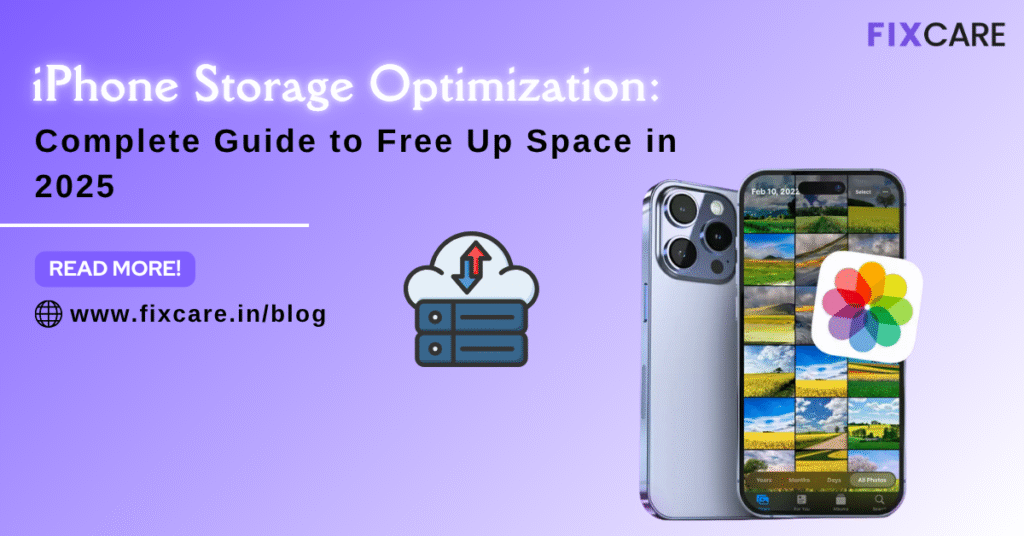
iPhone Storage Optimization: Complete Guide to Free Up Space in 2025

Table of Contents
If you’re an iPhone user in 2025, chances are you’ve seen that dreaded notification — “Storage Almost Full.” With 4K videos, large photo libraries, heavy apps, and iOS updates consuming space faster than ever, running out of storage is a common problem. Fortunately, you don’t need to delete everything to make room. With smart strategies and built-in tools, you can easily reclaim valuable space and boost your device’s performance.
In this blog article, we’ll walk you through everything you need to know about iPhone storage optimization — from identifying what’s taking up space to applying expert tricks that free up gigabytes within minutes.
Whether you own an iPhone 11 or the latest iPhone 15 Pro, these optimization methods will help your device run faster, smoother, and more efficiently — without compromising your data.
1. Why iPhone Storage Optimization Matters in 2025
In 2025, iPhones are more powerful than ever — but even with 256GB or 512GB variants, space fills up quickly. High-resolution media, AI-powered apps, AR features, and heavier system files mean even premium models can feel cramped.
Here’s why iPhone storage optimization is more crucial now than ever:
- Faster Performance: A cluttered iPhone slows down system operations. Optimizing storage keeps your device running at peak speed.
- Smooth Updates: Major iOS updates require free space to install. Regular optimization ensures you’re never stuck when an update drops.
- Improved Backup Efficiency: Backups are faster and smaller when your phone isn’t loaded with unnecessary files.
- Extended Device Lifespan: Less strain on your storage improves long-term performance and stability.
By mastering storage optimization, you’re not just freeing space — you’re future-proofing your device.
2. Check What’s Taking Up Space
Before you start deleting files randomly, it’s essential to see where your storage is going. Apple provides a built-in tool that breaks down usage by category.
Step-by-Step:
- Go to Settings → General → iPhone Storage.
- Wait a few seconds for your device to analyze storage.
- You’ll see a color-coded bar showing what’s using space — Apps, Photos, Media, iOS, and more.
- Below the chart, you’ll find recommendations such as “Offload Unused Apps” or “Review Large Attachments.”
This overview helps you make informed decisions about what to clean up.
3. Use Apple’s Built-in Storage Optimization Features
Apple has introduced several iPhone storage optimization tools over the years. In 2025, these are more powerful and user-friendly than ever.
a. Offload Unused Apps
This feature automatically removes apps you rarely use while keeping their data intact. When you reinstall the app, all your information is restored.
How to Enable:
Go to Settings → General → iPhone Storage → Enable Offload Unused Apps.
b. Optimize Photos
Your photo library is usually the largest consumer of storage. With Optimize iPhone Storage, your iPhone keeps smaller versions of photos locally and stores full-resolution images in iCloud.
How to Enable:
- Open Settings → Photos
- Select Optimize iPhone Storage
This can free up several gigabytes instantly if you use iCloud Photos.
c. Auto Delete Old Messages
Text messages and attachments pile up over time. Automatically deleting old ones helps reclaim hidden storage.
How to Enable:
Go to Settings → Messages → Keep Messages → Select 30 Days or 1 Year.
d. Review Large Attachments
From iPhone Storage settings, you can review and delete large attachments from Messages or Mail directly.
4. Clean Up Photos and Videos
Photos and videos often take up the majority of storage. Here are some iPhone storage optimization hacks to manage them effectively:
a. Delete Duplicate Photos
Use the Photos app’s Duplicates album (introduced in iOS 16) to merge or delete identical photos easily.
b. Clear Recently Deleted
Deleting photos doesn’t remove them instantly — they stay in Recently Deleted for 30 days.
Open Photos → Albums → Recently Deleted → Delete All.
c. Record in Lower Resolution
4K videos eat space fast. Switch to 1080p or 720p for regular use.
Go to Settings → Camera → Record Video → Choose 1080p at 30fps.
d. Use iCloud or External Storage
Move heavy media to iCloud Drive or external drives using a Lightning or USB-C adapter.
5. Manage Apps Smartly
Apps — especially games, editing tools, and social media — can consume gigabytes.
a. Delete Unused Apps
Review the list under Settings → iPhone Storage. If you haven’t opened an app in months, it’s time to uninstall it.
b. Clear App Caches
Some apps (like Safari, Spotify, and Instagram) build large caches.
- Safari: Go to Settings → Safari → Clear History and Website Data
- Streaming Apps: Reinstall or use in-app settings to clear cache.
c. Offload Heavy Apps
Offload rather than delete if you plan to use them again. Data is preserved for future use.
6. Optimize Messages, Mail & WhatsApp
Messaging apps store massive data over time — images, videos, voice notes, and documents. Cleaning these up is vital for iPhone storage optimization.
a. iMessage:
- Delete old conversations manually or set auto-delete.
- Review and delete large attachments from Settings → iPhone Storage → Messages.
b. Mail App:
Emails with attachments can consume storage. Go to Settings → Mail → Accounts, and remove old or unused mail accounts. You can re-add them later if needed.
c. WhatsApp:
- Open WhatsApp → Settings → Storage and Data → Manage Storage
- Review and delete large files, old media, or forwarded messages.
This alone can recover gigabytes of space.
7. Manage Downloads and Offline Files
a. Remove Offline Music and Videos
Apps like Spotify, Netflix, or YouTube store offline content. Check their download settings and remove old downloads.
b. Clear Download Folders
If you’ve downloaded PDFs, images, or documents, they might be stored in the Files app → Downloads. Clean this folder regularly.
8. Use iCloud and Third-Party Storage
For seamless iPhone storage optimization, offloading heavy data to the cloud is one of the smartest moves.
a. iCloud Drive
Apple’s native solution syncs your files, photos, and backups automatically. Plans start from 50GB and go up to 2TB.
Settings → [Your Name] → iCloud → Manage Storage.
b. Google Drive / Dropbox
Use Google Drive, Dropbox, or OneDrive to store less-used files and media. These apps also support automatic backup for photos and documents.
9. Manage System Data and Temporary Files
“System Data” (formerly “Other”) includes logs, caches, and temporary files. While you can’t delete them all manually, these tricks help reduce it:
- Restart your iPhone regularly to flush temporary files.
- Update iOS to the latest version for automatic cleanup.
- Reinstall problem apps that consume too much system storage.
- Backup and Restore if System Data is excessively large (over 10GB).
10. Regular Maintenance Routine for Long-Term Optimization
Storage optimization isn’t a one-time task. Make it part of your routine:
- Weekly: Delete screenshots and duplicate media.
- Monthly: Review unused apps and clear caches.
- Quarterly: Transfer files to cloud or external drives.
- Yearly: Perform a clean restore when upgrading iOS or switching devices.
By maintaining your storage regularly, you’ll never face “Storage Almost Full” again.
11. Pro Tips for iPhone Storage Optimization in 2025
- Use AI Cleanup Tools: New apps like Gemini Photos or CleanMyPhone intelligently detect unnecessary clutter.
- Optimize Widgets: Some widgets consume storage with cached data; remove unnecessary ones.
- Smart Backups: Use incremental backups with iCloud or Finder to avoid duplicate storage.
- Avoid Duplicate Apps: Stick to one photo editor, one music app, etc., to prevent overlap.
These smart habits go a long way in maintaining a lean and efficient iPhone.
12. When to Seek Expert Help
If you’ve tried all iPhone storage optimization methods and still struggle with performance or storage errors, there might be underlying issues — such as corrupted files, buggy updates, or hardware-level problems.
This is where professional assistance can help. Experts can perform deep diagnostics, system cleanups, and safe storage resets that go beyond standard user tools.
13. Common Mistakes to Avoid During Optimization
- Deleting essential system files: Always use Apple’s recommendations or verified tools.
- Skipping backups: Before major cleanups, back up your iPhone to iCloud or a computer.
- Ignoring updates: Outdated iOS versions may have storage bugs.
- Relying on one method: Combine multiple strategies for best results.
14. The Future of iPhone Storage Optimization
With Apple focusing on AI and device intelligence in iOS 19 and beyond, smart storage management is becoming more automated. Expect features like predictive cleanup suggestions, smarter iCloud integration, and AI-based duplicate detection.
Still, manual control remains key — knowing where to optimize ensures you stay ahead of space issues, even as apps grow heavier.
15. Final Thoughts
Storage management isn’t just about space — it’s about performance, stability, and efficiency. A well-optimized iPhone boots faster, runs smoother, and stays ready for updates and new features.
By following this complete iPhone storage optimization guide, you’ll not only reclaim valuable storage but also extend your device’s life and performance well into the future.
So next time your iPhone warns you about low storage, don’t panic — follow these tips, clean up your device, and enjoy a faster, more efficient experience.
Recent Blogs


Best Rated iPad Battery Replacement Near Me in bangalore


The Only Laptop You Need? Our In-Depth MacBook Air M4 Review
Post 5
Post 4
Post 3
Post 2
Post 1
Post 5
Post 4
Post 3
Get your Device Repaired Today
Recent News


Best Rated iPad Battery Replacement Near Me in bangalore



